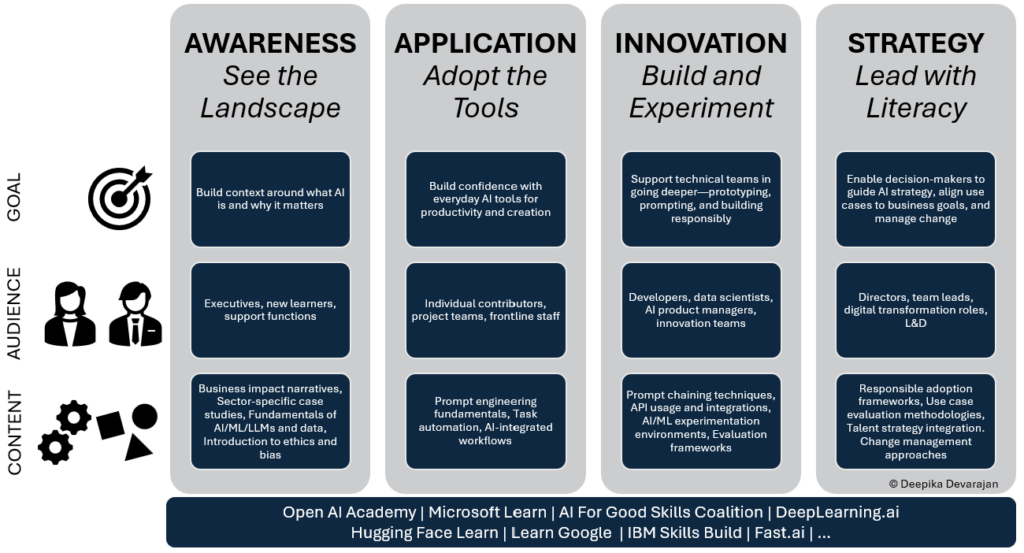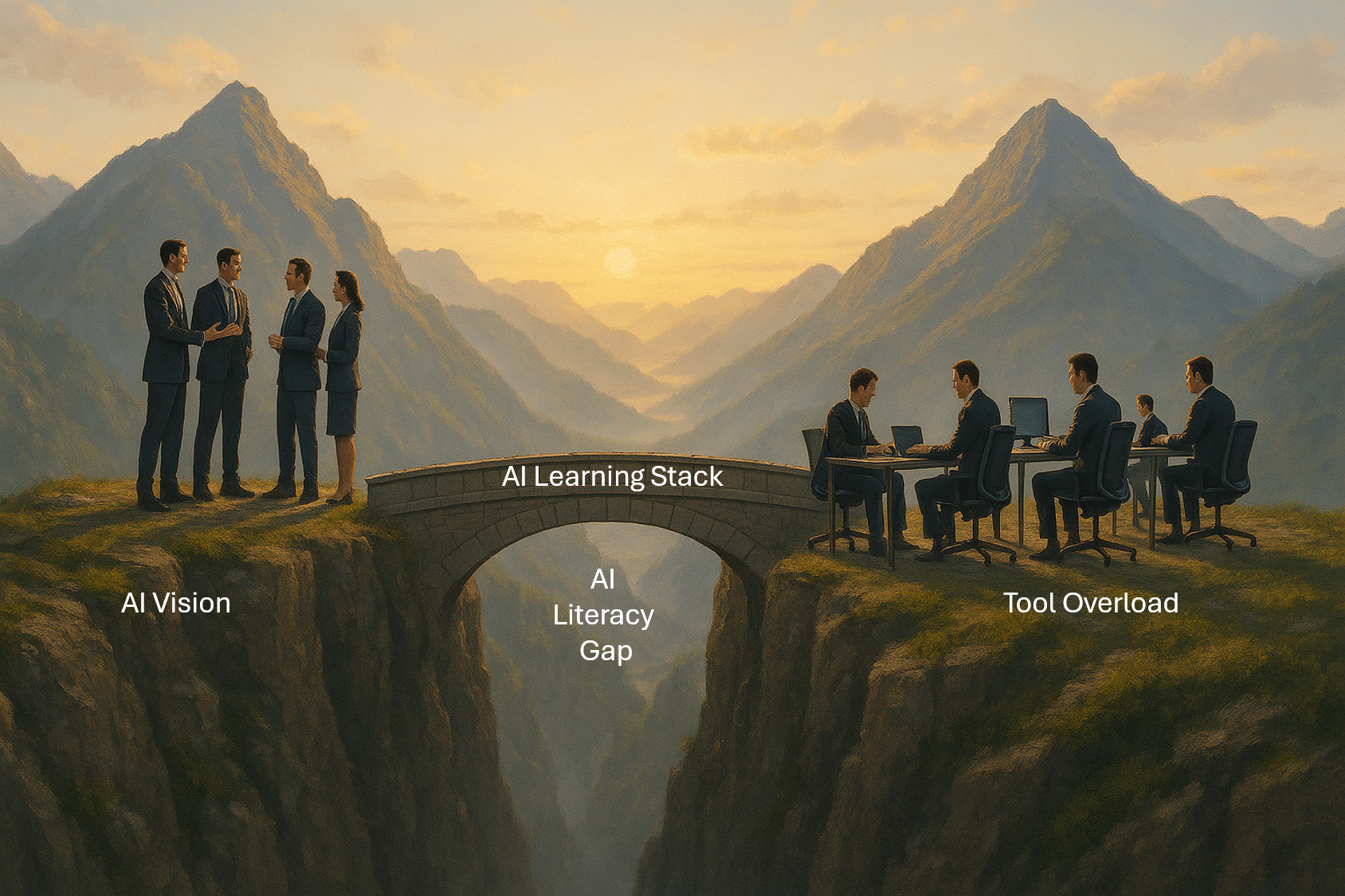At a recent AI/ML leadership summit, I witnessed a revealing moment. Senior executives from diverse industries on a panel were asked two questions:
“How important is AI literacy in your organization, on a scale of 1 to 10?”
The consensus: 9“What’s the current level of AI literacy across your workforce?”
The answer: 3
This six-point gap isn’t just a measurement. It’s a strategic vulnerability growing wider each day.
The Literacy Gap is a Leadership Gap
The disconnect is consistent across industries. Leadership recognizes AI’s importance, but organizational commitment to systematic reskilling remains tepid. In most companies, AI adoption happens organically, often driven by curious individuals experimenting after hours and weekends rather than through deliberate strategy.
Meanwhile, the technology accelerates. New tools emerge weekly. Employees feel overwhelmed and unsupported. And the gaps manifest across every level:
- Executives acknowledge AI’s importance but struggle to connect learning investments to business outcomes
- Managers lack frameworks to upskill teams or demonstrate tangible benefits
- Individuals navigate tool overload with unclear expectations and limited guidance
The question isn’t whether AI literacy matters – it’s how to transform good intentions into scalable action.
A Framework for Progress: The AI Learning Stack
Building meaningful AI fluency requires more than dropping links to a training portal. You need structured learning pathways aligned to roles and outcomes. I propose the AI Learning Stack – a layered approach to guide this journey with plug and play content resources:

1. Awareness: See the Landscape
- Goal: Build context around what AI is and why it matters
- Best for: Executives, new learners, support functions
- Includes: Business impact narratives, Sector-specific case studies, Fundamentals of AI, ML, LLMs, and data, Introduction to ethics and bias
2. Application: Adopt the Tools
- Goal: Build confidence with everyday AI tools for productivity and creation
- Best for: Individual contributors, project teams, frontline staff
- Includes: Prompt engineering fundamentals; Task automation; AI-integrated workflows
3. Innovation: Build and Experiment
- Goal: Support technical teams in going deeper—prototyping, prompting, and building responsibly
- Best for: Developers, data scientists, AI product managers, innovation teams
- Includes: Prompt chaining techniques, API usage and integrations, AI/ML experimentation environments, Evaluation frameworks
4. Strategy: Lead with Literacy
- Goal: Enable decision-makers to guide AI strategy, align use cases to business goals, and manage change
- Best for: Directors, team leads, digital transformation roles, L&D
- Includes: Responsible adoption frameworks; Use case evaluation methodologies; Talent strategy integration; Change management approaches
The learning resources can be leveraged in a plug and play manner into each of these layers. To explore some of my recommended structured learning content, check out Courses.
What Closing the Gap Could Look Like
Imagine a mid-sized manufacturing company where the gap is evident. The CTO and Head of Operations both recognize AI’s potential to transform efficiency, but implementation has stalled. A handful of engineers experiment with ChatGPT individually, but there’s no shared language, strategy, or organizational support.
Here’s how this company might systematically close their literacy gap:
- Executive Level: Leadership could identify three high-potential workflows—quality assurance, shift handovers, and documentation—prioritizing them for structured AI experimentation with clear success metrics.
- Management Level: Department heads might institute “AI Experiments” during weekly meetings, where small experiments would run with explicit hypotheses and team-wide sharing of results. Team leads could introduce quarterly AI literacy checkpoints and designate internal champions (“AI Sherpas”) to curate resources and guide colleagues. They create systems for sharing successes and standardizing effective approaches.
- Individual Level: Contributors test tools within existing workflows, document improvements, and build a collective prompt library mapped to specific job functions.
Within six months, AI could evolve from sporadic experimentation to integrated workflow. The technology would become part of their operational vocabulary, championed across teams, and embedded in their culture of continuous improvement.
Actionable Steps by Role: Creating a Cohesive Ecosystem
Effective AI literacy doesn’t happen in silos. When each organizational level plays its distinct role while supporting others, a powerful learning ecosystem emerges. Here’s how each level can contribute while strengthening connections across the organization:

For Executives:
- Position AI literacy as a strategic priority with dedicated resources, not a side project.
- Track meaningful impact metrics: productivity gains, workflows deployed, employee confidence.
- Create safe spaces for experimentation without immediate ROI pressure.
- Consistently ask: “Where is AI helping us now—and where should it help next?”
Connection Point: Set the vision and allocate resources that empower the entire organization while modeling a learning mindset.
For Managers:
- Identify 2-3 workflows for experimentation with “before and after” comparisons.
- Allocate resources for role-based learning: 4-6 hours quarterly for upskilling or learning stipends.
- Create a shared prompt library and internal “AI Playbook” with vetted approaches.
- Establish an “AI Sherpa” network to accelerate peer learning.
- Incorporate AI fluency into performance conversations.
Connection Point: Translate executive vision into practical systems while elevating individual successes into standardized practices.
For Individuals:
- Master three new applications for one AI tool you use regularly.
- Document and share one successful prompt or workflow weekly.
- Join a dedicated channel for AI questions and discoveries.
- Volunteer to test new approaches within your specific domain expertise.
Connection Point: Apply tools to real challenges while feeding practical insights to management about what works and where guidance is needed.
When these roles connect effectively, each strengthens the others. Executives who understand frontline challenges make better resource decisions. Managers who understand both organizational goals and individual capabilities guide more effective experimentation. And individuals who grasp the larger strategic context bring more intention to their daily AI use.
Bridging the Gap: The Leadership Opportunity
The AI literacy gap is substantial. But the opportunity to lead—deliberately, inclusively, iteratively—is even greater.
This isn’t just about technology adoption. It’s about organizational readiness for a fundamentally different operational landscape. The companies that close their literacy gaps fastest will unlock competitive advantages that compound over time.
Every role has agency in this transformation. The question isn’t whether your organization will develop AI literacy—it’s who will lead the way, and how quickly you’ll begin.
Start where you are. Move forward together. The gap only widens for those standing still.

